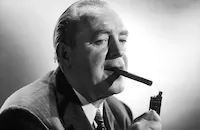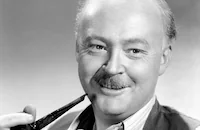Escape to Glory

Brief Synopsis
Cast & Crew
John Brahm
Pat O'brien
Constance Bennett
John Halliday
Melville Cooper
Alan Baxter
Film Details
Technical Specs

Synopsis
Amid rumors of war in Europe, a group of Americans rush homeward aboard a British freighter. On board are Mike Farrough, an American soldier of fortune; John Morgan, a district attorney who has put his office at the service of gangsters; Christine Blaine, Morgan's secretary and sweetheart; Larry Perrin, a fugitive murderer trailing Morgan to avenge a double-cross; Professor and Mrs. Mudge, an elderly couple; and Dr. Behrens, a German doctor. One day out of Liverpool, war is declared, and soon after, the freighter is halted to take on guns. When a German submarine appears, Farrough mans a gun and cripples the U-boat's periscope. Dr. Behrens, torn between ethics and his love for his fatherland, sends signals to the submarine with a shortwave transmitter. As the submarine tracks its prey, Perrin watches for his chance to kill Morgan, while Farrough and Christine fall in love. Discovering that the doctor has been signaling the submarine, Farrough places the transmitter aboard a small boat loaded with depth charges. To decoy the submarine away from the freighter, Perrin volunteers to pilot the boat in a suicide mission, and forces Morgan to accompany him. When the submarine attacks the decoy, the depth charges explode, sinking the sub and saving the freighter at the cost of Morgan's and Perris' lives.

Director

John Brahm
Cast

Pat O'brien

Constance Bennett

John Halliday

Melville Cooper

Alan Baxter

Edgar Buchanan

Marjorie Gateson
Francis Pierlot
Jessie Busley
Stanley Logan
Frank Sully
Erwin Kalser

Don Beddoe
Leslie Denison

Bruce Bennett
Dick Rich
Olaf Hytten
Frank Baker
Arthur Mulliner
Frank Benson
Dave Dunbar
James Kilgannon
Bobby Hale
Rex Post
Douglas Gordon
Hans Schumm
Norbert Schiller
Franz Von Altenberger
Fred Wolff
Hans Von Morhart
Paul Michael
Arno Frey
James Flatley
John Kascier
Steve Benton
Kay Smith
Crete Sipple
Ione Reed
Wyndham Standing
Crew
Lionel Banks
Sidney Biddell
Samuel Bischoff
Al Clark
C. C. Coleman
Lodge Cunningham
James Flatley
Fredric Frank
Frances Gehraty
Irene
Bert Kennedy
Thor Liljiucrantz
Joe Murphy
Franz Planer
Ida Schumaker
Kay Smith
M. W. Stoloff
Casey Whitney
P. J. Wolfson

Film Details
Technical Specs

Articles
Escape To Glory -
The film is an action picture above all else - the arrival of the German submarine portends an explosive confrontation between the two vessels, with a deluge of special effects to assist. The story was written, at least in part, by Fredric M. Frank, who authored the screenplays to many of Cecil B. DeMille's most spectacularly outlandish productions. The just-over-an-hour runtime all but ensures that action takes precedence over the human drama; it is a far cry from Alfred Hitchcock's handling of at-sea tensions in Lifeboat (1944), a more authentic chamber drama that prioritized character over action and aimed for a certain level of sophistication and prestige.
This is not to say, however, that the drama in Escape to Glory is altogether disposable. The characters embody many appealing archetypes of 1930s Hollywood, with O'Brien doing his boozehound act and Halliday and Baxter cycling through a number of gangster movie tropes. In fact, it is when the interpersonal friction is thickest (and when the rote action-movie conventions are in abeyance) that director John Brahm really shines.
Brahm is a relatively obscure figure in Hollywood history, best known for infusing optimum menace into two horror-thrillers starring Laird Cregar - The Lodger (1944) and Hangover Square (1945) - and for later directing 12 episodes of The Twilight Zone. While Escape to Glory is an early work, and far less accomplished than his later outings, it contains intimations of what was to come. For instance, it is commonly pointed out that "Judgment Night," one of his Twilight Zone entries, revives the shipboard claustrophobia approach with wartime drama that marks Escape to Glory. It is easy to speculate that the film's more inspired moments are Brahm's doing, while its sundry imperfections can be attributed to Columbia's unit-production formula for wartime programmers.
If Escape to Glory was early in Brahm's career, after which he would cut ties with Columbia and moved to a posher studio (Twentieth-Century Fox), it marked the beginning of Constance Bennett's decline as a star. Once one of Hollywood's highest-paid actresses, with high-end contracts with both MGM and RKO, Bennett was now relegated to less glamorous roles in lower-budget features. Still, as Pat O'Brien's love interest, she handles herself admirably, and as her stardom waned, she found ample work in radio and theater, and even found some success as a businesswoman with a cosmetic company to her name.
By Stuart Collier

Escape To Glory -
Quotes
Trivia
Notes
The working titles of this film were Passage West and Submarine Zone.














